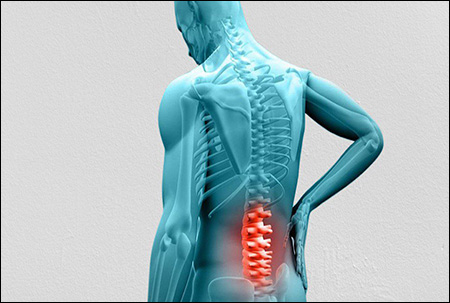Research Shows That 97% of Herniated Discs Don’t Require Surgery and Its Ayurvedic Management
Abstract
Disc herniation is one of the most common degenerative spine disorders diagnosed with abnormalities of the lumbar spine. It affects two to three percent of the population worldwide. The ratio is higher among the adult population. In the initial stages, it includes lumbalgia and then progresses to sciatica. Symptoms are seen in the early stage of the disease which is within four to six weeks. The first and foremost line of treatment is conservative management by physiotherapy and medication associated with nerve root block. In Ayurveda, it is cured by various procedures under Panchkarma. Surgical treatment is indicated only when there is a motor defect of more than three degrees. Later it represents a medical emergency. But research shows that 97% of cases are cured by conservative management and the Ayurveda line of treatment.

Introduction
Lumbar disc herniation consists of displacement of the pulposus nucleus (the content of the intervertebral disc ). It generally happens in the posterolateral region. It all depends upon how much volume is herniated hence it will cause irritation of lumbar nerve roots and the dural sac. The pain that is clinically associated with it is known as sciatica. Disc herniation is one of the most common diagnoses among the degenerative abnormalities of the lumbar spine. In Ayurveda, it is believed that there is vitiation of vata dosha which causes pain and stiffness. The herb pacifies the vata dosha and strengthens muscles and relaxes the nerves in a natural way. Panchakarma procedures are performed to subside the aggravated vata dosha.
- Lumbar region:- If the herniated disc is in the lumbar region then it may cause pain in the buttocks, thigh, and calves. Pain that is associated with the sciatic nerve is known as sciatica.
- Cervical region:- If the herniated disc is in the cervical region then it may cause problems in the neck, arms, and shoulders. It may also cause stiffness and weakness of muscles.
- Thoracic region:- If the herniated disc is in the thoracic region then the middle back is most likely to be affected.
DIAGNOSIS
Physical Examination
- Checking the reflexes
- Sensitivity to touch
- Gait
- Muscle strength
- Range of action+
- Site of pain
Radio Diagnosis
- X-Ray ( C/spine, L/spine )
- CT Scans
- MRI Scan
- Discogram
- Myelogram
AYURVEDIC OVERVIEW
All three doshas are responsible for herniated disc problems. Predominantly vata dosha is involved as compared to pitta and Kapha dosha. The problem of the herniated disc occurs in these steps:-
- Lack of nutrition inside the disc involved will lead to damage to blood arteries. This is also known as degenerative disc disease.
- This also leads to changes in shape and character inside the jelly.
- When the movement goes in the wrong direction it will cause extrusion of the spinal disc. It may become more progressive.
The above three mentioned points clearly talk about the involvement of three doshas.
- As in the first point, it’s all about nutrition. if there is no nutrition or less nutrition thus it is a pitta imbalance.
- When the shape of the jelly is disturbed it is due to Kapha dosha.
- The movement of the disc in the wrong direction is due to vata dosha.
So here all three doshas are involved so it’s not only dependent upon the vata dosha.
AYURVEDIC TREATMENT OF HERNIATED DISCS
The Ayurvedic line of treatment is one of the safest lines of treatment as the research had shown over time. It states that there is no need for surgery in almost all cases. Today this is the need of the hour. Ayurvedic treatment does not require any surgical operation on the back of the body and moreover, you do not have to face any kind of problem in the future as well. A person can get rid of his problem without any side effects.
3 steps management
- Oilation of the spine and surrounding muscles
- Relaxing the muscle and the body
- Alignment of the spine in it,s real shape
1. Oilation of the spine
Dryness of the spine can cause stiffness of the spine. The adequate use of oil can lead to bringing back the natural condition of the spine and its flexibility.
2. Relaxing the muscle and the
When we start oilation of the body muscle fiber loses the deep-seated toxins and relaxes to perform normal duties. This process helps in the third process.
3. Alignment of the spine in its real shape
A mechanical problem cannot be healed without proper manipulation. Manipulation should be long-lasting and intelligent otherwise it could be a serious issue.
PANCHKARMA FOR HERNIATED DISCS
The therapies like Abhyanga, Sweden, Nasyam, Vasti, etc are done as per the requirement. The procedure primarily has the following steps:-
- Abhyanga:- Massage with medicated oil has proven good in the treatment of herniated discs.
- Swedana:- It helps in relaxing the body and reenergizing it. This will help in strengthening the cell.
- Shodhana:- This will help in expelling toxicity from the body. It will detox the body and purify the body. The person will feel rejuvenated after the therapy.
HERBAL REMEDIES FOR HERNIATED DISC BY PLANET AYURVEDA
Planet Ayurveda is a GMP-certified company offering products worldwide. All the products are prepared by following the ayurvedic texts under the guidance of MD Ayurveda experts. All the products are safe and devoid of all kinds of adverse effects. Let’s have a look at the formulations:-
DISC CARE PACK
- Boswellia curcumin
- Yograj Guggul
- Hakam Churna
- Aamvatantak Churna
- Mahatriphala Ghrit
PRODUCT DESCRIPTION
1. BOSWELLIA CURCUMIN
Boswellia Curcumin capsules prepared by Planet Ayurveda are the best preparation prepared using standardised extract of Shallaki (boswellia serrata) and haridra (Curcuma longa) for the inflammatory disorder. The results are long-lasting and the anti-inflammatory effect is permanent. This herb is effective and safe to consume as there are no side effects. Boswellia extract is made from tree gum. Boswellia contains boswellic acid which is a very good anti-inflammatory. It supports healthy joint functioning. Curcumin is a rich antioxidant moreover it also supports the immune system and Maintains the normal functioning of the body.
Dosage:- 2 capsules twice daily with warm water, after meals.
2. YOGRAJ GUGGUL
Yograj Guggul is a classical ayurvedic preparation that makes the balance vata in the body. It is prepared by mixing various ingredients. It contains Chitraka ( Plumbago zeylanica), Yavani (Trachyspermum ammi), Karavi (Piper chaba), Pippalimoola (Piper longum), etc. All herbs are taken in fine powdered form. After the addition of guggul, it is converted into tablet form. Its strength is approximately 500 mg.
Dosage:- 2 tablets twice daily with warm water, after meals.
3. HAKAM CHURNA
It is a great preparation by Planet Ayurveda. This is a classical herbal preparation that is proved to be very effective in herniated discs and back pain disorders. This preparation is also known as Tridoshic Rasayan as this acts upon all the three doshas. This churna is a mixture of herbs like Chandershoor (Lepidium sativum), Kalonji (Nigella sativaa ), Methi (Trigonella foenumgraecum), Ajwain (Trachyspermum ammi), etc. It tends to bring vata in balance and supports digestion as well.
Dosage:- 1 tsp twice daily with warm water, after meals.
4. AAMVATANTAK CHURNA
Aamvatantak Churna is a mixture of various ingredients like Ashwagandha ( Withania somnifera ), Haridra (Curcuma longa), Methika (Trigonella foenumgraecum), Surnajan (Colchicum luteum ), Gorakhmundi (Sphaeranthus indicus ), Shunthi (Zingiber officinale). It helps in maintaining a good digestive system and joints as well.
Dosage:- 1 tsp twice daily with warm water, after meals.
5. MAHATRIPHALA GHRIT
It is prepared by mixing Kwath dravya, Kalk dravya, and Swarasa dravya. Herbs that are abundantly present are Triphala ( Emblica officinalis, Terminalia bellirica, Terminalia chebula ), Bhringraj ( Eclipta alba ), Pipal ( Ficus religiosa ), etc. It is known to have anti-inflammatory properties. It has the ability to act as an antioxidant. It also helps in improving overall health.
Dosage:- 1 tsp of melted ghrit twice daily, after meals.
CONCLUSION
A herniated disc is a pathological condition that is also known as a slipped disc. Ayurvedic management is effective almost in all patients. So it is concluded that there is no need for surgery hence 97% of cases are cured by conservative management only. Within four to six weeks symptoms start to reverse. Still, it is recommended that expert advice should be taken before starting the treatment.
Dr. Vikram Chauhan
Latest posts by Dr. Vikram Chauhan (see all)
- ALTERNATIVE AYURVEDIC TREATMENT FOR CHRONIC KIDNEY DISEASE - July 24, 2024
- Ayurvedic Treatment for Liver Disease with Herbal Remedies - July 22, 2024
- Ayurvedic Treatment For Diabetes Mellitus With Herbal Remedies - July 4, 2024
- Ayurvedic Aspect Of Liver And Management Of Liver Diseases - July 3, 2024
- Natural Ayurvedic Treatment For Fibromyalgia With Herbal Remedies - July 2, 2024






